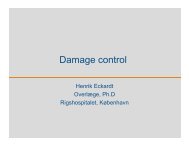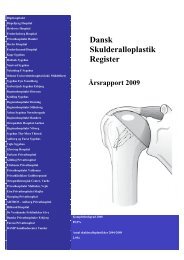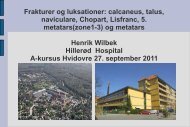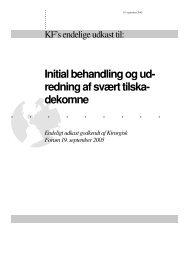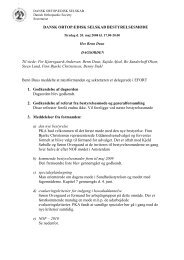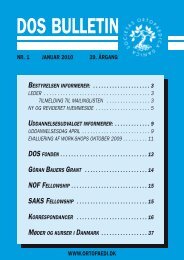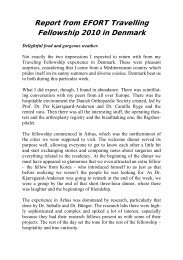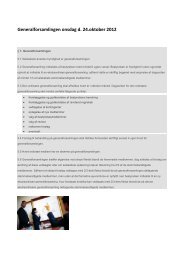DOS BULLETIN - Dansk Ortopædisk Selskab
DOS BULLETIN - Dansk Ortopædisk Selskab
DOS BULLETIN - Dansk Ortopædisk Selskab
You also want an ePaper? Increase the reach of your titles
YUMPU automatically turns print PDFs into web optimized ePapers that Google loves.
2010-378_<strong>DOS</strong> nr. 3 2010 29/09/10 10:08 Side 114<br />
Cyst volume in the acetabulum and femoral head<br />
decrease after periacetabular osteotomy<br />
Inger Mechlenburg, Jens R. Nyengaard, John Gelineck, Kjeld Søballe<br />
Department of Orthopaedics, University Hospital of Aarhus; Stereology<br />
and Electron Microscopy Laboratory, University of Aarhus,<br />
Department of Radiology, University Hospital of Aarhus<br />
Background: Bone cysts in patients with hip dysplasia, is the result of degeneration<br />
or defects of the articular cartilage and elevated local stresses in the subchondral<br />
bone.<br />
Purpose: In a series of consecutively included patients scheduled for periacetabular<br />
osteotomy (PAO), we examined how many had acetabular or femoral<br />
head cysts preoperatively and measured the volume of these cysts. 1 and 2 1 /2<br />
years after PAO we re-measured the volume of the cysts to investigate whether<br />
the cysts developed further after PAO.<br />
Methods: 24 females and 4 males with hip dysplasia had the hip magnetic resonance<br />
imaged (MRI) before PAO, 1 and 2 1 /2 years and after surgery. The location<br />
and number of cysts were noted and the total cyst volume in each patient<br />
was estimated with a model- based stereological method. Two angles were<br />
measured on pre- and postoperative AP radiographs: center- edge (CE) and<br />
acetabular index (AI) angle.<br />
Findings: 11 of 28 patients had acetabular cysts preoperatively (21 cysts, mean<br />
total cyst volume/patient 3.44 cm3, SD 6.712) and 1 patient had a cyst in the<br />
femoral head (volume 8.05 cm3). One year after PAO, 13 patients had acetabular<br />
cysts (19 cysts, mean total cyst volume/patient 1.96 cm3, SD 3.97) and 2<br />
patients had femoral head cysts (4 cysts, mean total cyst volume/patient 3.98<br />
cm3, SD 4.10). 2 1 /2 years after surgery 13 patients had acetabular cysts (16<br />
cysts, mean total cyst volume/patient 0.96 cm3, SD 1.70) and 2 patients had<br />
femoral head cysts (4 cysts, mean total cyst volume/patient 0.80 cm3, SD 0.72).<br />
Mean total acetabular cyst volume/patient decreased significantly from 1 year<br />
to 2 1 /2 years after PAO = 0.04. All acetabular cysts were located anterolaterally<br />
in the acetabulum except for one that was posterolateral. The femoral head cysts<br />
were positioned anterolaterally and anteromedially. The radiographic evaluation<br />
on preoperative and postoperative radiographs in the 28 hips showed that the CE<br />
angle increased from mean 13 (- 27 to 35) degrees to mean 31 (20 to 41) degrees<br />
after PAO, and the AI angle decreased from mean 18 (7 to 39) degrees to mean<br />
2 (-4 to 10) degrees.<br />
Conclusion: In conclusion, the radiographically measured angles demonstrated<br />
optimal surgical correction of the acetabulum at PAO. The mean total cyst volume/patient<br />
decreased significantly between 1 and 2 1 /2 years after PAO. We<br />
believe this is a result of decreased local stresses in the subchondral bone after<br />
PAO which also indicates that redirection of the acetabulum reduces the risk of<br />
progression of osteoarthritis in the operated hip.<br />
114



